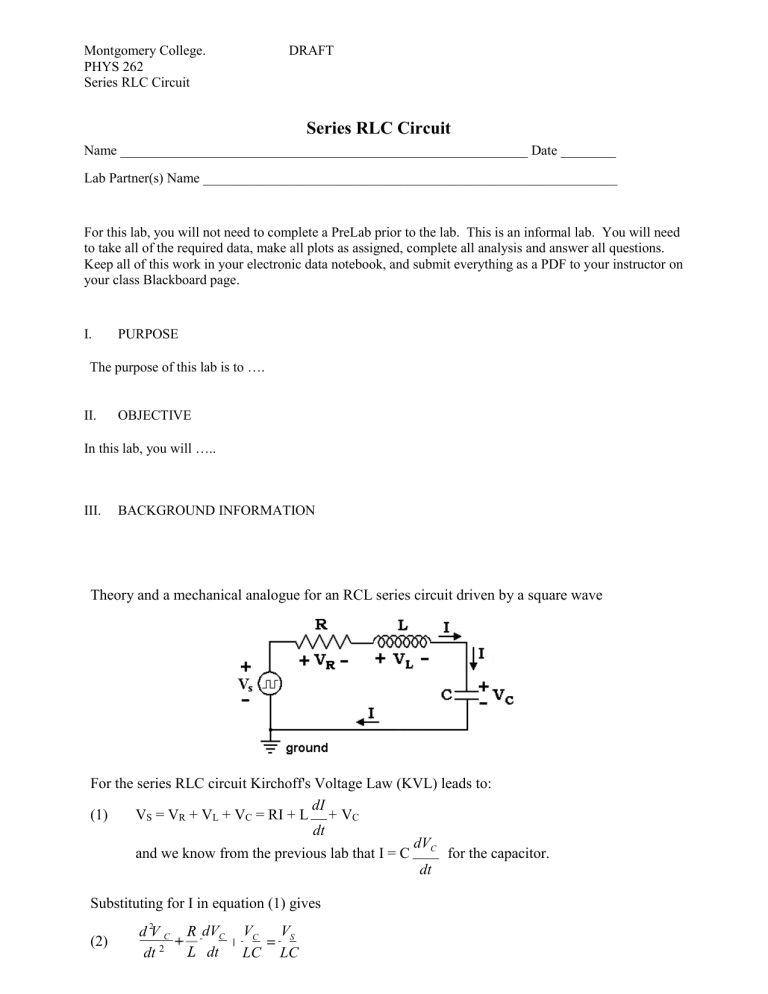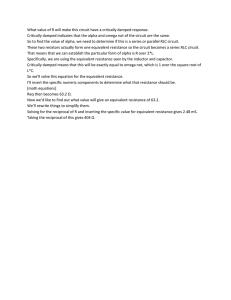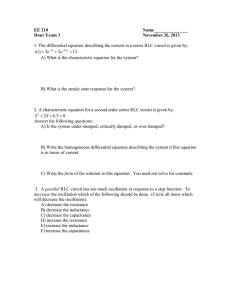Uploaded by
fungoalan
Series RLC Circuit Lab: Analysis & Simulation

Montgomery College. PHYS 262 Series RLC Circuit DRAFT Series RLC Circuit Name ___________________________________________________________ Date ________ Lab Partner(s) Name ____________________________________________________________ For this lab, you will not need to complete a PreLab prior to the lab. This is an informal lab. You will need to take all of the required data, make all plots as assigned, complete all analysis and answer all questions. Keep all of this work in your electronic data notebook, and submit everything as a PDF to your instructor on your class Blackboard page. I. PURPOSE The purpose of this lab is to …. II. OBJECTIVE In this lab, you will ….. III. BACKGROUND INFORMATION Theory and a mechanical analogue for an RCL series circuit driven by a square wave For the series RLC circuit Kirchoff's Voltage Law (KVL) leads to: dI (1) VS = VR + VL + VC = RI + L + VC dt dV and we know from the previous lab that I = C C for the capacitor. dt Substituting for I in equation (1) gives (2) d 2V C dt 2 dVC dt VC LC VS LC Montgomery College. PHYS 262 Series RLC Circuit DRAFT This is an inhomogeneous 2nd order differential equation. Since VS is effectively a constant (either 0 or a positive value, due to the square wave), we need only consider the homogeneous solution, Vs = 0. The homogeneous solution is shown below. t (3) VC (t) Voe cos (4) 2L and R where 1 LC R 2L 2 2 1 2 0 This, of course, represents a sinusoidally oscillating function with exponentially decaying amplitude. For a mechanical analogue, think about the mass-spring system studied in Lab #2. If you hang a mass on a spring and perturb the system by pulling the mass below the equilibrium point and then let go of the mass, the mass-spring system will oscillate around equilibrium and gradually lose energy (and amplitude) due to mechanical friction and air resistance. Exactly the same process happens with the RLC circuit. The square wave perturbs the circuit (gives it energy) and the circuit then oscillates with a decaying amplitude; the resistor uses up some of the electrical energy (I2R) with each oscillation and so the amplitude (VC) decreases exponentially. Notice that τ, the decay time constant, is given by 2L so the greater the R, the smaller the τ, the faster the decay. R Montgomery College. PHYS 262 Series RLC Circuit DRAFT Undamped System Suppose that we have an undamped system, then R = 0 → 1/τ = 0 and VC(t) = Vo cos ωot where ωo = LC ω0 is called the "resonance" frequency and it is the frequency at which an undamped system will oscillate. Compare this to ωo = for the mass-spring system studied earlier in Lab #2. Damped System The damped oscillator does indeed have a 1/LC term in the equation for ω, but it also has a R 2 . This reflects the rate at which energy is being removed by the subtracted term of 2L resistive losses, which is steadily decreasing the speed of the oscillator and hence also causes a reduction in the frequency of the oscillation. This damped frequency is called the natural frequency of the system, to distinguish it from the resonance frequency, 1 LC R 2L R 2L natural frequency It now remains to consider what will happen as the resistance in an RLC circuit is continually increased -- in particular, what happens if (R/2L)2 becomes larger than 1/LC. This leaves a negative quantity under the radical, so that the cosine function now has an imaginary argument. Now it is a very interesting property of the theory of complex numbers that sines and cosines of imaginary quantities become real exponential functions, and vice-versa. Thus, for large R, no oscillations remain and the response is purely exponential. The value of R at which the oscillations just disappear is called the critical damping resistance, since this circumstance gets the system to its equilibrium value as rapidly as possible without going past the equilibrium value. Critical damping occurs exactly at the point where the frequency goes to zero, ie. 1 LC Rcrit 2L 2 0 → Rcrit L C Critical damping is also of great interest in many mechanical systems, eg. door-closing mechanisms which get the door to the closed position as rapidly as possible, but with the condition that it arrive at this position with zero speed in order to prevent slamming into the frame. Think about how you might critically damp the mass-spring system in Lab #2. Your car has a mass-spring damped system (actually 4 of them), more or less critically damped. What component causes the damping? Why is it important to have good shock absorbers? 2 Montgomery College. PHYS 262 Series RLC Circuit DRAFT IV. MATERIALS - V. The Simulation for this lab is at https://www.everycircuit.com A spreadsheet (Excel or Google sheets) Electronic Data notebook PROCEDURE 1) Log into the simulation at EveryCircuit.com Make a new RLC circuit that consists of a resistor R= 60 ohm, an inductor L = 22 mH a capacitor C = 0.01 F and a square wave generatorsource, with the oscilloscope channel 2 connected across the capacitor; and channel 1 across the square wave generator. Watch your ground leads carefully. - A time bar scale is given on x-axis. Slide the time bar scale to have 1ms which is half of the time period. Adjust the waveform in such a way that the underdamped curve starts from one side of the time bar scale and ends on the other side of it. - Take a snap shot of the screen and print out the simulation. You should see the amplitude of the voltage oscillation decaying exponentially. Envelope the decaying oscillation. Measure the length of the time bar scale carefully with a physical metric ruler that you will need to hold up to the screen. Alternatively, you can print out a screenshot and overlay a ruler. Develop a scaling between the distance measurements and the time scale of your trace. (i.e., how many milliseconds / millimeter). Then measure the distance horizontally from the starting point up to the point where the exponential decay curve drops to half of the initial voltage 𝑉𝑜 . �� = 1 Half-life Decaying oscillation Length of time bar scale 34 mm=1ms −� �� Montgomery College. PHYS 262 Series RLC Circuit DRAFT - Calculate the frequency and the half-life of the resulting signal and compare with theoretical expectations. 2. Try at least 3 LC combinations to confirm your understanding of the method. Predict in advance whether a particular component change should increase or decrease the frequency of the oscillation; increase or decrease the decay time. 3. Return to the original L and C values, and add an adjustable resistor with flywheel into the circuit. Adjust the resistor to obtain critical damping. Get the R from the simulation and compare with theoretical predictions. Examine what happens to the response as R is varied from near zero to values larger than critical, and explain this behavior in terms of the energy loss processes. VIII. SUBMITTAL REQUIREMENT This is an informal lab. All results should be within your Electronic Data Notebook. Compile your data tables, plots, calculations, and the answers to questions into 1 pdf file and submit to your class Blackboard page.


